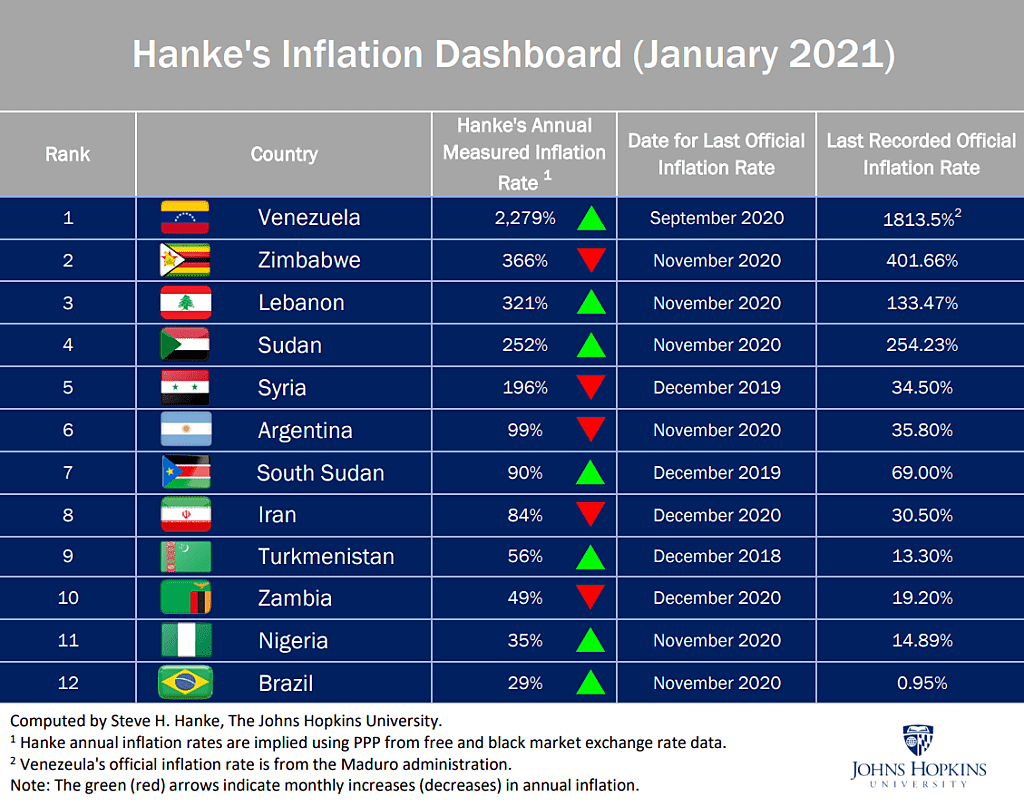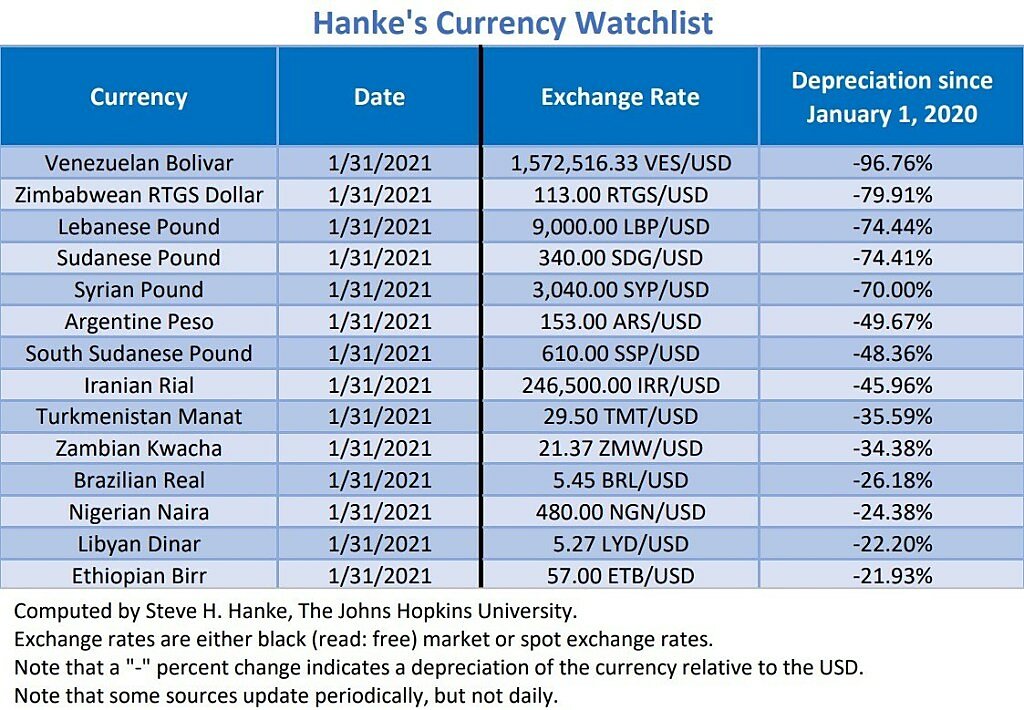In the first month of 2021, Turkey and Libya dropped off of Hanke’s Inflation Dashboard. Now the Dashboard contains a dozen countries that, by my measure, are realizing annual inflation rates of 25 percent per year or greater. The inflation rates presented on the Dashboard below are measurements that I make each day by using exchange-rate data in combination with Purchasing Power Parity (PPP) theory. For countries in which annual inflation rates have reached 25 percent or more, the PPP method has proven to be very reliable. These results can differ markedly from reported official inflation rates. For example, Argentina’s current official inflation rate is reported to be 35.8 percent per year, whereas the PPP measure for Argentina is 99 percent per year. The divergence between my inflation measures and the official measure is even more dramatic in Brazil, where the official inflation rate is only 0.95 percent per year, but my measure it is 29 percent per year.

Unsurprisingly, the currencies of all twelve countries on the Dashboard have suffered massive devaluations against the U.S. dollar since January 2020. Hanke’s Currency Watchlist below shows that the rank order of the countries’ inflation rates and currency devaluations match up. Indeed, inflation rates and currency devaluations are joined at the hip like conjoined twins.

Currency devaluations are therefore associated with increased inflation rates, and increased inflation rates are associated with slower rates of GDP per capita growth. So if you want to slow the rate of growth in per capita GDP (read: prosperity), currency devaluations will do the trick.
Why, then, do politicians embrace the idea that currency devaluations are an elixir that can reduce trade and current-account deficits and stimulate growth? After all, this idea remains a theory in search of facts. Indeed, it’s a delusion. If devaluations were anything more than a delusion, places like Argentina and Brazil would be the most competitive places in the world, and they would realize massive trade and current-account surpluses. For the devaluers, there would be no shortage of economic growth and prosperity.
I believe that most businessmen and politicians are attracted to the devaluation delusion because they suffer from a myopia. They assign an irrational weight to what they perceive as the near-term benefits of a currency devaluation without even so much as considering the longer-term costs. Viewed through such an irrational, myopic lens, devaluations always appear to be attractive.
To understand the source of this myopia, consider the advertised goal of devaluations. A devaluation is supposed to increase the price of foreign-produced goods and services and decrease the price of domestically produced goods and services. These changes in relative prices are supposed to switch domestic and foreign expenditures away from foreign-produced goods and services towards those produced domestically. This is supposed to improve the devaluing country’s international trade balance and accelerate its growth rate.
For the public, this argument has a certain intuitive appeal. After all, a devaluation is seen as nothing more than a price reduction for domestically produced exports, and price reductions are always seen as a means of increasing the quantity of goods sold. When it comes to currency devaluations, the analysis is not that simple, however. Following a devaluation, inflation will pick up and so will the costs of producing goods and services, including exports, in the country that has devalued its currency. Inflation will steal away any of the potential, short-term, competitive benefits that might initially accompany the devaluation. That’s why devaluations are a delusion. And that’s why countries that are addicted to devaluations always fail to gain a competitive edge and why they are always mired in volatile, slow economic growth.
And, if that’s not bad enough, there is a game-theoretic aspect that explains why the devaluation strategy is a loser’s game — even in the short run. In 1947, the famous Cambridge don Joan Robinson penned “Beggar-My-Neighbor Remedies for Unemployment.” She not only coined the phrase “beggar-my-neighbor,” but concluded that so-called competitive devaluations would be unsuccessful in achieving their advertised objectives. Among other things, Robinson wrote that a devaluation would prompt a retaliation in the form of a counter competitive devaluation. Thus, the initiator of a currency war could, and would, always be neutralized, even in the short run — checkmate.
